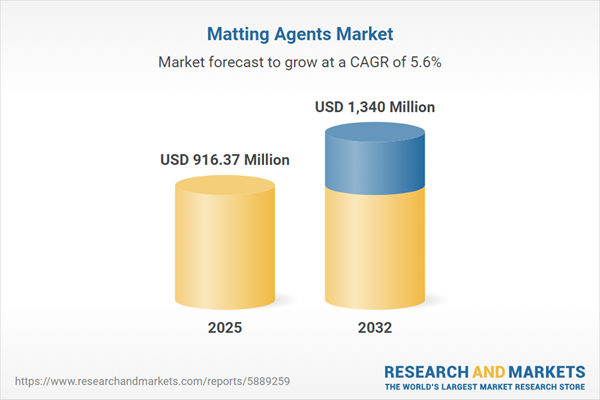Speak directly to the analyst to clarify any post sales queries you may have.
The matting agents market is responding to complex industry shifts encompassing regulatory changes, sustainability imperatives, and the demand for advanced surface finishes. Senior decision-makers require clear intelligence to navigate these developments and capitalize on emerging opportunities in coatings and materials innovation.
Market Snapshot: Matting Agents Market Growth and Momentum
The matting agents market grew from USD 870.58 million in 2024 to USD 916.37 million in 2025. This sector is projected to maintain solid momentum, advancing at a CAGR of 5.59% to reach USD 1.34 billion by 2032. Such growth is supported by sustained advancements in chemistry, manufacturing technologies, and evolving application requirements across multiple industries.
Scope & Segmentation of the Matting Agents Market
This report provides comprehensive segmentation and granular analysis to guide strategic planning:
- Type: Polymer-based matting agents; Silica-based matting agents; Wax-based matting agents
- Formulation: Powder; Solventborne; UV/EB; Waterborne
- Application Area: Architectural coating; Industrial coating; Leather coating; Printing inks; Wood coating
- End-Use Industry: Aerospace; Automotive; Construction; Textiles
- Regional Coverage: Americas (including United States, Canada, Mexico, Brazil, Argentina, Chile, Colombia, Peru); Europe, Middle East & Africa (covering United Kingdom, Germany, France, Russia, Italy, Spain, Netherlands, Sweden, Poland, Switzerland, GCC, Israel, South Africa, Nigeria, Egypt, Kenya); Asia-Pacific (with China, India, Japan, Australia, South Korea, Indonesia, Thailand, Malaysia, Singapore, Taiwan)
- Key Companies: Aalborz Chemical, Akzo Nobel N.V., Anhui Kingcham New Materials, Arkema S.A., Axalta Coating Systems, BASF SE, BCD Chemie, BioPowder by Schilling, BYK-Chemie, Cabot Corporation, CHT Germany, Deuteron, Estron Chemical, Evonik Industries, Fine Cause, Goyen Chemical, Henan Minmetals East Industrial, Honeywell International, Hubei Hoyonn Chemical Industry, Imerys S.A., ISF Group Limited, ISHIHARA SANGYO KAISHA, J.M. Huber Corporation, Jinsha Precipitated Silica Manufacturing, Jinwei Chemical, Mitsubishi Chemical Group, MÜNZING Chemie, PPG Industries, PQ Corporation, SINO SUNMAN INTERNATIONAL, Stahl Holdings, The Lubrizol Corporation, Thomas Swan & Co., W. R. Grace & Co., Yantai Sunychem Int'l, Zhejiang Shuangcai New Materials
Key Takeaways for Senior Leaders
- Demand for matting agents is shaped by stricter regulations around VOCs, leading to increased adoption of waterborne and low-VOC solutions.
- Innovations such as hybrid composite particles, engineered polymers, and nanotechnology are expanding the functional potential of matting agents beyond aesthetics, addressing durability, scratch resistance, and advanced performance needs.
- Manufacturers are forming strategic partnerships across the supply chain—integrating efforts from formulation specialists, chemists, and raw material suppliers to accelerate innovation pipelines and respond to shifting market pressure.
- Regional diversity in regulations and end-user requirements mandates tailored go-to-market strategies and locally adapted product portfolios.
- Sustainability initiatives, including the integration of bio-based and recyclable materials, are influencing product development and procurement decisions across major buying sectors.
Tariff Impact: Strategic Realignments in the Supply Chain
The introduction of United States tariffs in 2025 directly influenced the matting agents supply chain. The result was a reassessment of raw material sourcing and the pursuit of near-shoring or regional production to shield against margin impacts. Supply chain partners actively diversified their procurement networks, expanded local manufacturing, and explored backward integration for core ingredients. These responses have fostered a more resilient and flexible market structure, enabling industry participants to manage volatility and optimize delivery even amidst unforeseen policy changes.
Methodology & Data Sources
The research utilizes a hybrid methodology of primary interviews with key industry stakeholders, secondary research across technical and regulatory publications, and robust quantitative and qualitative analytical frameworks. Cross-verification and iterative expert review ensure reliable and actionable insight for strategic stakeholders.
Why This Report Matters
- Supports more confident investment and procurement decisions by clarifying rapidly evolving regulatory and technological landscapes.
- Helps benchmark against best-in-class competitors and adjust to specific regional and end-market opportunities.
- Provides a strategic foundation for innovation, sustainability implementation, and operational risk mitigation in the matting agents sector.
Conclusion
The matting agents market is evolving toward multi-functional performance and heightened sustainability. Targeted innovation, strategic partnerships, and adaptive supply chains will remain critical for leaders seeking to enhance competitiveness and achieve lasting growth.
Additional Product Information:
- Purchase of this report includes 1 year online access with quarterly updates.
- This report can be updated on request. Please contact our Customer Experience team using the Ask a Question widget on our website.
Table of Contents
3. Executive Summary
4. Market Overview
7. Cumulative Impact of Artificial Intelligence 2025
Companies Mentioned
The companies profiled in this Matting Agents market report include:- Aalborz Chemical, LLC
- Akzo Nobel N.V.
- Anhui Kingcham New Materials Co., Ltd.
- Arkema S.A.
- Axalta Coating Systems, LLC
- BASF SE
- BCD Chemie GmbH
- BioPowder by Schilling Ltd.
- BYK-Chemie GmbH
- Cabot Corporation
- CHT Germany GmbH
- Deuteron GmbH
- Estron Chemical, Inc.
- Evonik Industries AG
- Fine Cause Co.,Ltd.
- Goyen Chemical
- Henan Minmetals East Industrial Co., Ltd.
- Honeywell International Inc.
- Hubei Hoyonn Chemical Industry Co., Ltd
- Imerys S.A.
- ISF Group Limited
- ISHIHARA SANGYO KAISHA, LTD.
- J.M. Huber Corporation
- Jinsha Precipitated Silica Manufacturing Co., Ltd.
- Jinwei Chemical Co., Ltd.
- Mitsubishi Chemical Group Corporation
- MÜNZING Chemie GmbH
- PPG Industries, Inc.
- PQ Corporation
- SINO SUNMAN INTERNATIONAL
- Stahl Holdings B.V.
- The Lubrizol Corporation
- Thomas Swan & Co. Ltd.
- W. R. Grace & Co.
- Yantai Sunychem Int'l Co., Ltd.
- Zhejiang Shuangcai New Materials Co., Ltd.
Table Information
| Report Attribute | Details |
|---|---|
| No. of Pages | 188 |
| Published | November 2025 |
| Forecast Period | 2025 - 2032 |
| Estimated Market Value ( USD | $ 916.37 Million |
| Forecasted Market Value ( USD | $ 1340 Million |
| Compound Annual Growth Rate | 5.5% |
| Regions Covered | Global |
| No. of Companies Mentioned | 37 |









